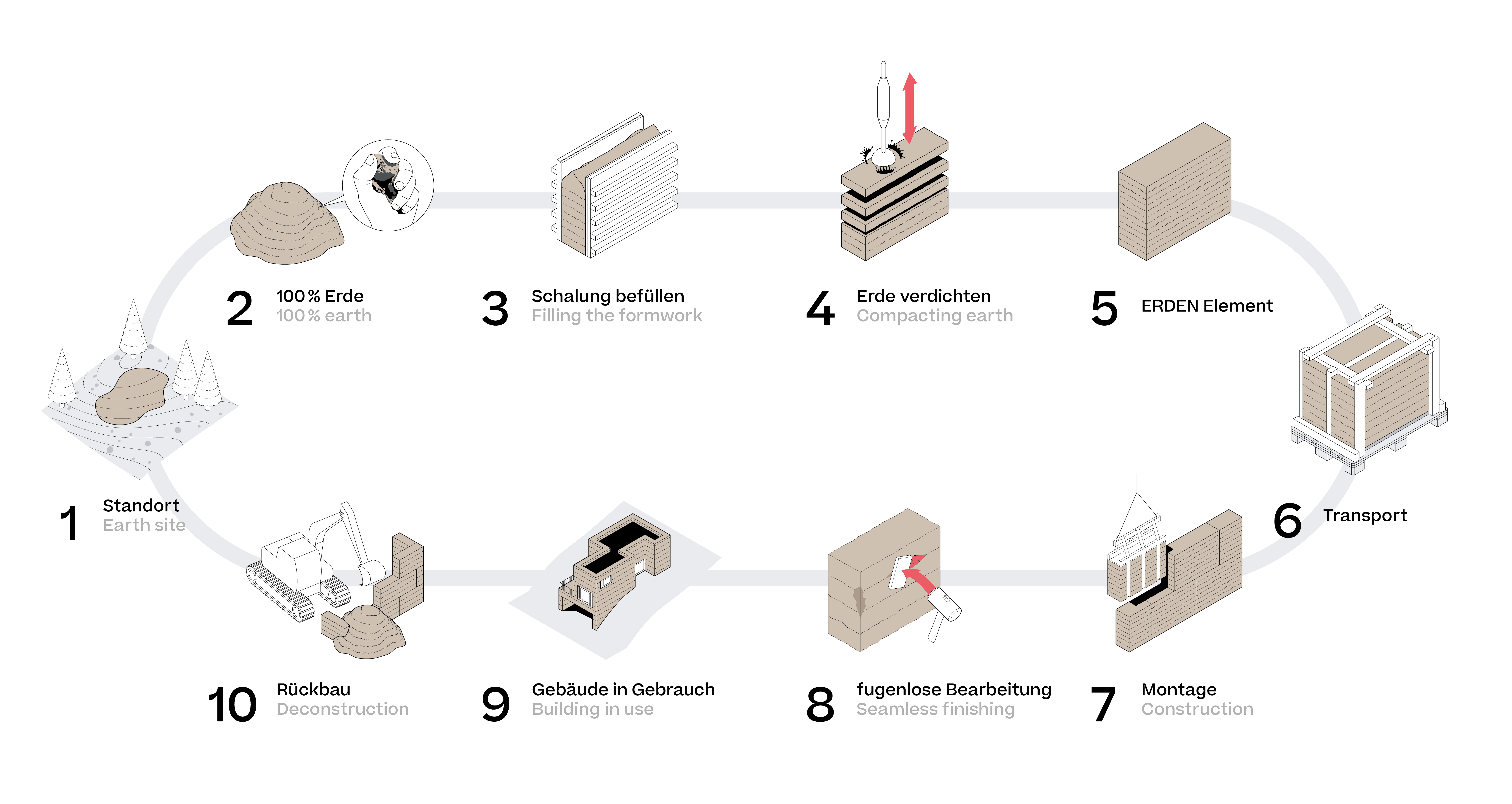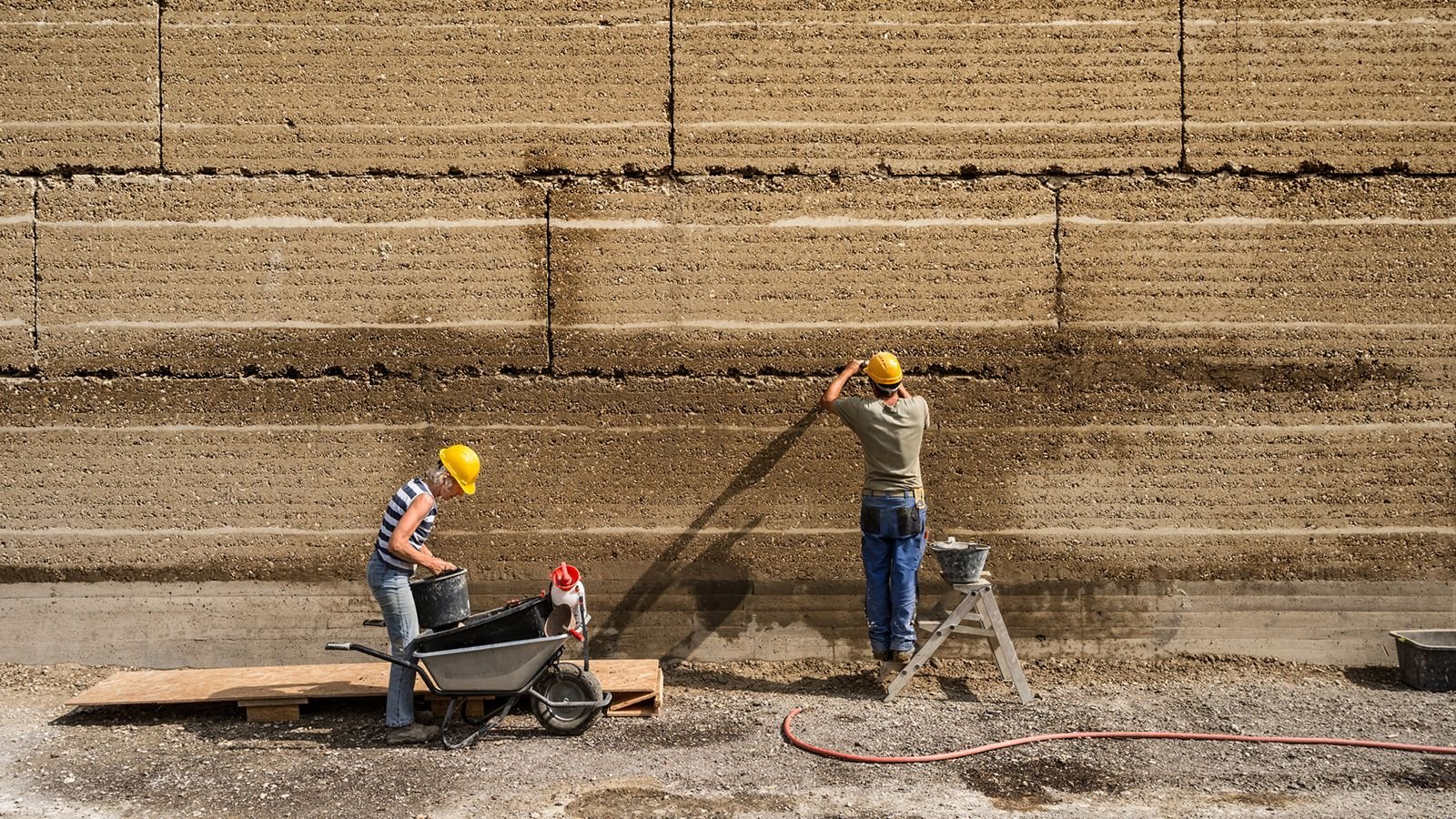Warum Lehm
Why earth
Warum mit Lehm bauen?
Es gibt ein Gedankenspiel, das mit aller Deutlichkeit zeigt, warum Lehmbau ökologisch sinnvoll ist. Stellen Sie sich ein Stück Land vor. Auf diesem Grundstück befindet sich nichts als Erde. Und aus genau dieser Erde wird ein Haus gebaut. Das klingt vielleicht ein bisschen direkt. Ist es auch. Aber Stampflehm ist genau das, nichts anderes als verarbeitete Erde. Unsere vorgefertigten Bauelemente sind 100 % natürlich, 100 % recycelbar, regeln passiv das Raumklima und bieten eine haptische Materialität, die perfekt zur zeitgenössischen Architektur passt.
Why build with earth?
There is a scene that shows with all clarity why earthen construction makes ecological sense. Imagine a piece of land. On this plot there is nothing but earth. And from exactly this earth a house is built. That may sound a bit direct. It is. But rammed earth is just that, nothing but processed earth. Our prefabricated building elements are 100% natural, 100% recyclable, passively control indoor climate, and offer a haptic materiality perfectly suited to contemporary architecture.

Wer die Erde liebt, baut mit ihr
Das ökologische Resümee von Stampflehm ist unübertroffen. Kein anderes Material hat einen kleineren Fußabdruck auf unserem Planeten. Das Rohmaterial und das fertige Produkt sind ein und dasselbe. Erde aus dem Boden wird ausgegraben und aufbereitet. Wir fügen ein wenig Kies oder Ton hinzu, um sie zu optimieren, mischen sie mit Wasser und voilà!
Das Material ist also von Haus aus nachhaltig, aber auch die Prozesse drum herum. Wir schließen Kreise im Baukreislauf, denn die Erde stammt aus Aushubmaterial von lokalen Baustellen. Dieses Material, das wir bekommen, wird normalerweise kostenpflichtig abtransportiert und deponiert. Mit unserem Partnern nehmen wir dieses Material auf, zerkleinern und sieben es einsatzbereit. So entsteht ein gegenseitiger Nutzen für uns und die lokalen Deponien, der Abfall und Emissionen reduziert.
Aber der vielleicht größte Vorteil von Stampflehm ist, dass er vollständig recycelbar ist. Eine errichtete Wand kann abgebaut und erneut mit Wasser gemischt werden, um jedes Mal genau dasselbe hochwertige Baumaterial zu sein. Und was nicht benötigt wird, kann ohne Behandlung in den Boden zurückgeführt werden, da keine Chemikalien verwendet werden. Kein anderes Baumaterial kann dies leisten.
Who love the Earth, build with it
Rammed earth’s ecological résumé is unmatched. No other material has a smaller footprint on our planet. The raw material and the finished product are one and the same. Earth from the ground is dug up and conditioned. We add a little gravel or clay to optimise it, mix it with water and voilà!
So the material is innately sustainable but so are processes around it. We close loops in the building cycle because the earth comes from excavated material from local building sites. This material we get is usually transported away, at cost, for dumping. With our partners, we take this material, crush and sieve it ready for use. This creates a mutual benefit for us and local excavators, reducing waste and emissions from freight.
But perhaps rammed earth’s greatest advantage is it’s fully recyclable. A built wall can be broken down and mixed with water again to create the exact same quality building material every time. And what is not needed can be returned to the ground without treatment as it contains no chemicals. No other material can do this.

Kühle Sommer und warme Winter
Es gibt nichts Gemütlicheres, als von Erde umgeben zu wohnen. Mit seiner hohen thermischen Masse kann Stampflehm eine Menge Wärme speichern. Sie wirkt wie ein Wärmepuffer, der tagsüber die Sonnenwärme absorbiert und die Innentemperatur kühl hält. In den kälteren Nächten gibt sie diese Energie dann wieder ab, um die Innenräume warm zu halten. Durch die Verringerung der täglichen Temperaturextreme wird der Energieverbrauch reduziert.
Aber es ist nicht nur Wärme. Unstabilisierte Stampflehme kann auch Feuchtigkeit speichern. Die lehmige Oberfläche hat eine Mikrostruktur, die wie ein Schwamm wirkt. Wenn die Luftfeuchtigkeit im Raum hoch ist, saugt die Wand überschüssige Feuchtigkeit auf. Ist der Raum zu trocken, gibt sie die gespeicherte Feuchtigkeit wieder ab. Ein Raum mit Stampflehmwänden hält eine Luftfeuchtigkeit von etwa 55 % aufrecht, die perfekte Luft für Komfort und Gesundheit der Atemwege.
Cool summers and warm winters
There is nothing more comfortable than living surrounded by earth. Having high thermal mass, rammed earth can store a lot of heat. It acts as a heat buffer, absorbing the sun’s heat during the day, keeping the inside temperature cool. Then, during the colder nights, it releases that energy to keep inside spaces warm. By lowering the daily extremes in temperature, energy consumption is reduced.
It’s not just heat, though. unstabilised rammed earth can also store moisture. The earthen surface has a micro-structure that acts like a sponge. When humidity is high inside, the wall soaks up excess moisture. When the room is too dry, it releases stored moisture. A room with rammed earth walls will maintain about 55% humidity, the perfect air for comfort and respiratory health.

Sieht gut aus, fühlt sich
besser an
Stampflehm, wenn er nicht stabilisiert ist, kann schöne und atmungsaktive Wände mit fugenlosen Oberflächen schaffen. Nach dem Rammen kommt die Handwerkskunst ins Spiel. Durch den Prozess der Retusche können Lücken aufgefüllt und Ecken scharfkantig gemacht werden, indem dasselbe lose Lehmmaterial eingehämmert wird. Fügen Sie ein wenig Wasser, ein wenig Erde und eine Menge Ellenbogenschmalz hinzu, und die Oberfläche kann perfekt retuschiert werden, wieder und wieder. Sobald sie getrocknet ist, können riesige Wandflächen als eine ungebrochene Oberfläche aus strukturierter Erde entstehen.
Anders als bei stabilisierten Stampflehm- oder Betonwänden werden bei unseren Wänden keine unschönen Bewegungsfugen benötigt. Das liegt daran, dass die Struktur des Materials in der gesamten Masse Mikrorisse aufweist. Diese winzigen, unsichtbaren Risse ermöglichen es der Stampflehmwand, Bewegungen im Gebäude aufzunehmen, ohne zu reißen. Bei dem von den weltbekannten Architekten Herzog & de Meuron entworfenen Ricola-Kräuterzentrum erstreckt sich die Gebäudefassade über hundert Meter ohne Bewegungsfuge.
Looks good, feels better
Rammed earth, when it’s not stabilised, can create beautiful and breathable walls with seamless surfaces. After ramming, the craftsmanship comes in. Through the process of retouching, gaps can be filled in and corners can be made sharp by hammering in the same loose earthen material. Add a little water, add a little earth, add a lot of elbow grease, and the finish can be made perfect, again and again. Once it dries, huge wall faces can appear as an unbreaking surface of textured earth.
Unlike with stabilised rammed earth or concrete walls, ugly movement joints are not needed in our walls. This is because the structure of the material has micro-fissures throughout the entire mass. These tiny invisible tears allow the rammed earth wall to absorb movement in the building without cracking. On the Ricola Herb Centre designed by world renowned architects, Herzog & de Meuron, the building facade stretches over a hundred metres with no movement joint.

Ruhe und Stille
Schwer und massiv. Das bedeutet im Grunde, dass Stampflehm sehr gute akustische Eigenschaften hat. Das liegt an der Materialmischung und an den Eigenschaften des Lehms. Stampflehm hat eine große Oberfläche, die aus Partikeln unterschiedlicher Härte und Größe besteht. Diese Zusammensetzung bietet große Vorteile für die Raumakustik und reduziert den Nachhall in Innenräumen deutlich.
Betrachtet man unsere Werkshalle, so liegt sie merkwürdig nah an unseren Nachbarn. Wohnbebauung und Industriegebiete sind normalerweise weiter voneinander entfernt. Wir konnten so nah bauen, weil die Schallübertragung mit massiven Erdwällen so stark reduziert werden kann. So sehr, dass wir auf der einen Seite dieser Wand unseren lauten Betrieb führen können und auf der anderen Seite immer noch Menschen angenehm wohnen.
Peace and quite
It’s heavy and it’s massive. This basically means rammed earth has very good acoustic properties. This is due to the material mix and the properties of clay. Rammed earth has a lot of surface area made up of particles of varying hardness and size. This composition offers great advantages for room acoustics, significantly reducing echo indoors.
If you look at our factory hall, it sits strangely close to our neighbours. Residential housing and industrial zones are usually separated more than this. We were able to make this work because sound transmission can be reduced so much with massive earth walls. So much so that we are able to run our noisy operations on one side of this wall and still have people living on the other.

Aber warum bauen dann nicht alle mit Lehm?
Trotz seiner ökologischen, funktionalen und ästhetischen Qualitäten wurde in jüngster Zeit kaum mit Stampflehm gebaut. Vor allem, weil die Erfahrung mit dem Material verloren gegangen ist. Für uns war jeder Stampflehmbau, wenn man so will, ein Prototyp. Dementsprechend hoch waren die Kosten. Dank der 35-jährigen Arbeit von Martin Rauch verliert Stampflehm nun diese Exklusivität. Mit der Einführung des ERDEN-Vorfertigungsverfahrens haben wir den Lehmbau vereinfacht und erschwinglicher gemacht. Das bedeutet, dass der Wunsch, ein eigenes Lehmhaus zu bauen, für immer mehr Menschen zur Realität wird. Der Weg dorthin ist aber noch lang. Regulatorische Hürden und ein breiteres Wissen über die Arbeit mit Stampflehm stellen noch Herausforderungen dar. Aber der Aufschwung hat begonnen. Die Umwelt braucht dringend natürliche Baulösungen. Warum baut nicht jeder mit Lehm? Nun, es ist nur eine Frage der Zeit.
But then why doesn't everyone build with earth?
Despite its ecological, functional, and aesthetic qualities, rammed earth has hardly been built with in recent times. Mainly because experience with the material had been lost. For us, every rammed earth building has been, if you will, a prototype. And so the costs were correspondingly high. Thanks to 35 years of research work by Martin Rauch, rammed earth is now losing that exclusivity. With the introduction of the ERDEN prefabrication process, we have simplified earthen construction and made it more affordable. This means that the desire to build one's own earthen house is becoming a reality for more and more people. There is still a way to go. Regulatory hurdles and a wider knowledge of working with rammed earth still pose challenges. But the revival has started. The environment urgently needs natural building solutions. Why doesn’t everyone build with earth? Well it’s just a matter of time.
